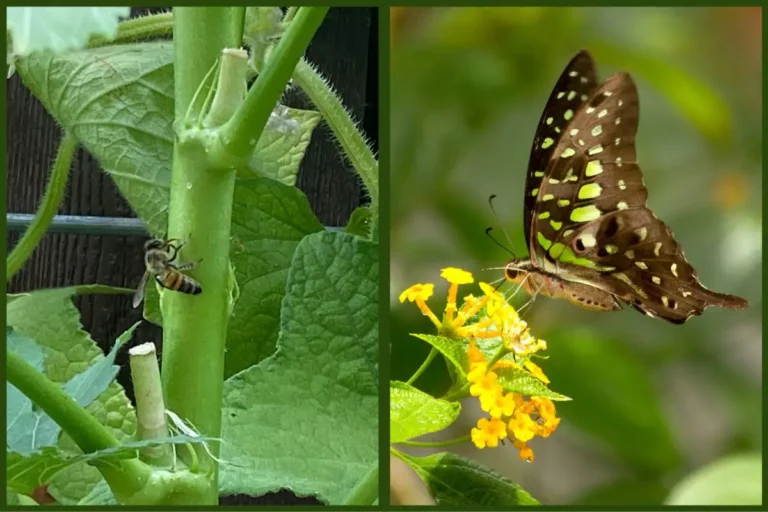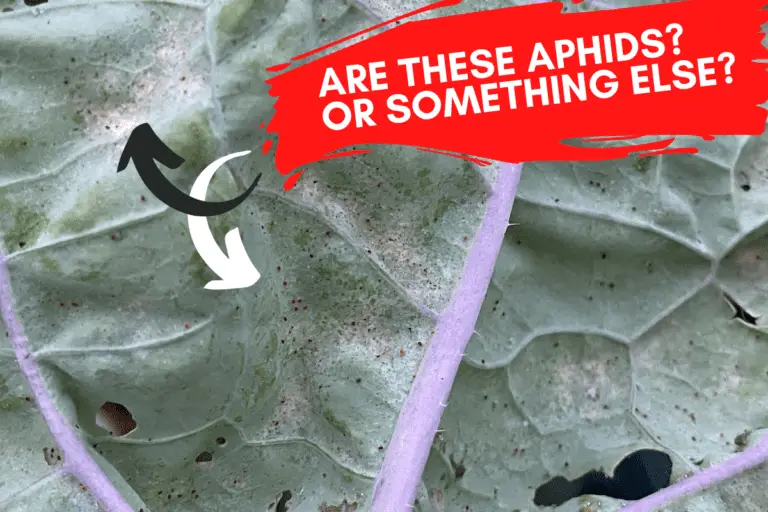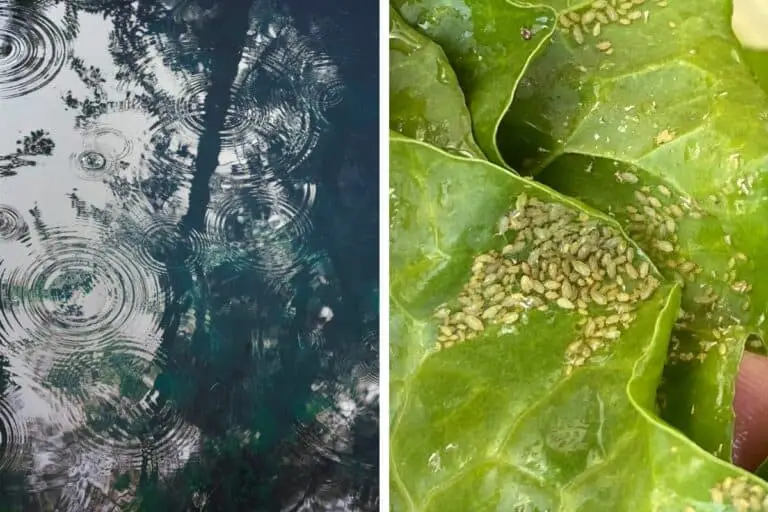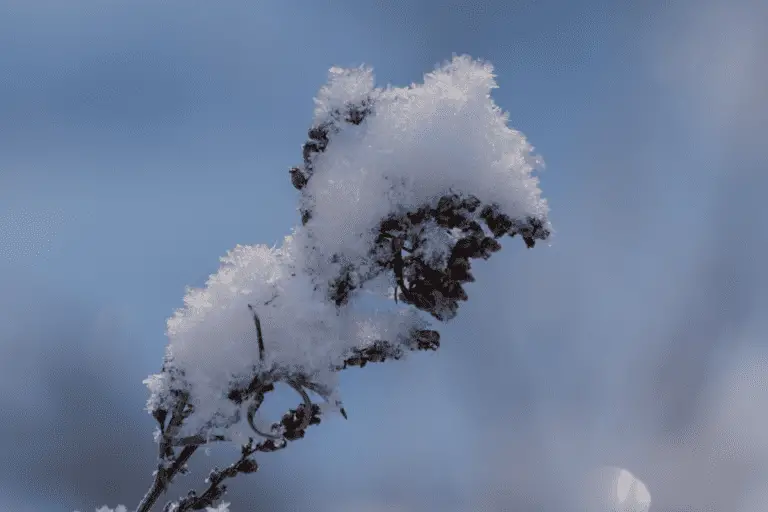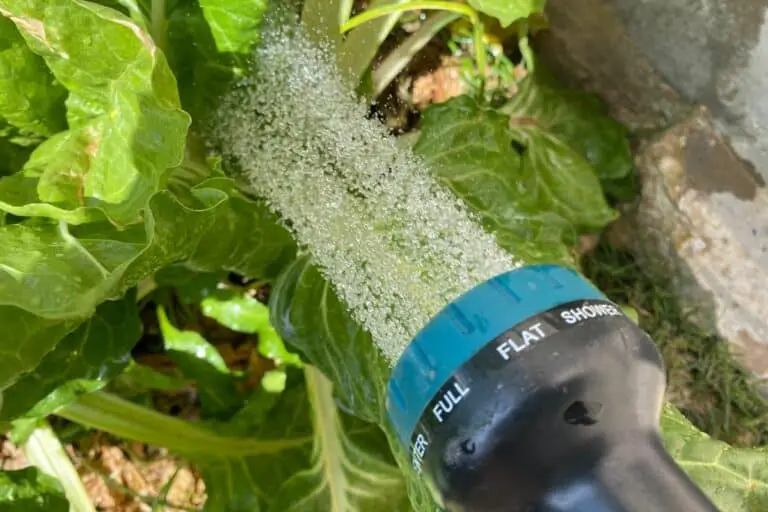12 Reasons Why Aphids Keep Coming Back + 3 Simple Fixes
If you’ve been gardening for any amount of time, you’ve likely had to deal with aphids at least once each season…and likely over and over year after year.
It seems they’re always coming back, but why is that? Why won’t they just stay away for at least a few years?
With nearly 5,000 species and the ability to reproduce quickly and survive in both hot and cold climates, aphids return each year in search of over 200 plant species, from flowers, shade trees, and shrubs to vegetables and citrus plants, including most popular garden varieties.
To put it in simple terms, here are 10 reasons why aphids keep coming back to your garden, with more detailed explanations below:
- Aphids Are a Global Pest
- There Are Nearly 5,000 Aphid Species
- Aphids Attack 200+ Different Plants
- Aphids Give Live Birth
- Aphids Reproduce Quickly
- Aphids Produce Winged Aphids
- Aphids Get Help from Wind
- Aphids Get Help from Humans
- Aphids Get Help from Animals
- Aphids Can Survive in Sub-Freezing Temperatures
- Aphids Can Easily Overwinter in Eggs
- Aphids Are Guarded by Ants
Now that you’ve seen the overview, let’s take a closer look at what makes aphids so incredibly resilient.
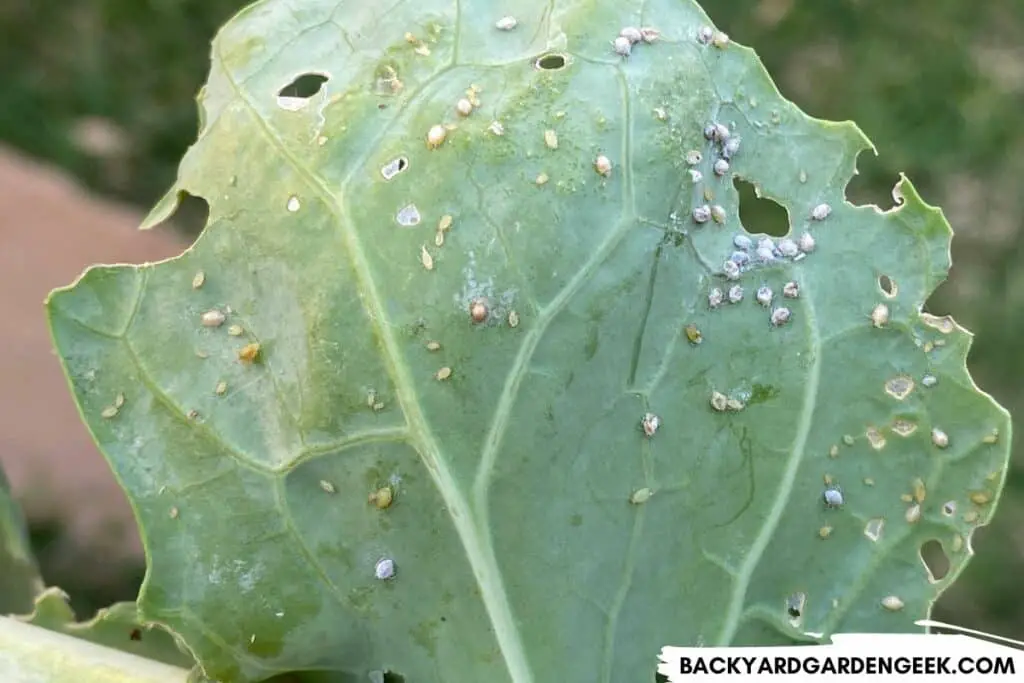
8 Reasons Why Your Plants Keep Getting Aphids
There are all kinds of reasons why aphids may be showing up on your property regularly— depending on where you live, what kind of plants you’re growing, and what the weather’s like, to name a few—I’d like to focus on 8 overall factors that contribute to recurring aphid infestations.
1. Aphids Are a Global Pest
Here’s the worst news: One of the main reasons why aphids keep showing up in your garden is that they’ve spread to nearly all corners of the world.
You obviously won’t find them in areas where winters remain at subfreezing temperatures for weeks or months at a time, but they’re practically everywhere else, from dry, arid regions to subtropical forests.
This doesn’t mean that all aphids have acclimated to all environments. That’s hardly the case.
But it does mean that certain aphid species have found ways to survive and thrive on different kinds of plants that are endemic to different corners of the world.
2. There Are Nearly 5,000 Aphid Species
Last time I looked, they were over 4,700 different aphid species, with more than 1,300 located in North America.
Here’s the good news for those gardeners who live in the United States or Canada: Of those 1,300+ species, only 400 aphid species pose a threat to plants and crops.
But that’s also bad news because that means that there are more than 400 different species that could show up on your property, depending on what you’re growing this season.
You’ll never know which aphids have arrived on your property unless you’ve got a degree in entomology with a special interest in aphids. But they come in all kinds of colors: black, green, pink, red, yellow, and white, to name a few.
With so many species out there, it’s no surprise that they keep showing up in your garden.
3. Aphids Attack 200+ Different Plants
I don’t think anyone knows exactly how many plant varieties aphids will actually attack, but there’s very good evidence that, at the very minimum, the number is well over 200.
Aphids are phloem sap suckers, and since most plants on the planet use phloem tubes to carry nutrients throughout the plant, aphids have evolved to suck the sap from many different kinds of plants.
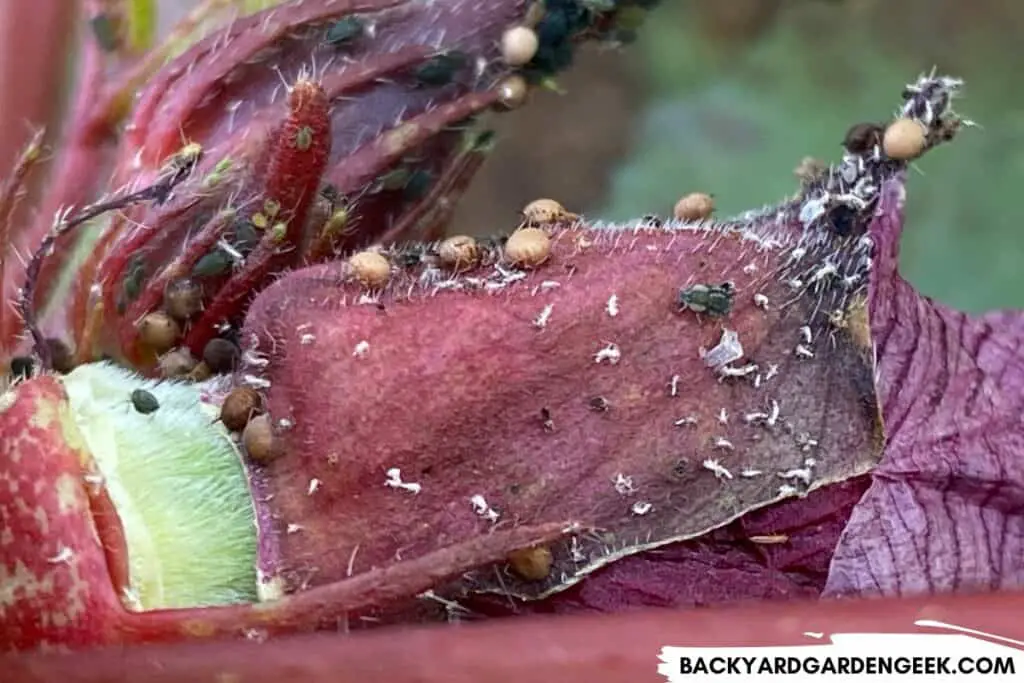
Unfortunately, for us gardeners, the list of plants that aphids love to attack as long. There are very few plants that they’ll stay away from 100% of the time.
Read my article on 21 plants that aphids love to attack if you want to learn more about it.
4. Aphids Give Live Birth
Unlike so many other insect species, female aphids give birth to live aphids, a process known as parthenogenesis.
Simply put, this means that female aphids don’t need male aphids to reproduce. They can do so on their own.
Different aphid species have different birth rates, but in general, female aphids give live birth once every 3-4 days. And what’s even more horrifying for us gardeners is the fact that those live offspring come into the world with the next generation of aphids already developing inside their little bodies.
This is why aphids can take over gardens even though they’re quite small and easily squishable. With no need for male aphids until the arrival of fall–since there’s no need to produce eggs until cold weather arrives–female aphids will give birth throughout the year and can produce 50+ aphid offspring during a single lifespan.
5. Aphids Reproduce Quickly
As I’ll explain in more detail below, you’ve got to watch out for aphids and then kill them off quickly once you first spot them. If you don’t, a tiny aphid infestation can quickly turn into something far worse.
Generally speaking, female aphids can reproduce once every 3-4 days, although that’ll vary depending on the species, the time of year, the availability of resources, and other environmental factors.
This is why aphids are often found in small to large clusters on your plants. Once they’re born, they rarely leave the place of their birth, so you’ll likely see several successive generations of aphids in one place if they’ve been there long enough.
Once you notice clustering patterns, you need to act quickly. At this point, all of those aphids are likely capable of giving live birth to new aphids, so a single cluster can lead to exponential aphid growth if you’re not careful.
6. Aphids Produce Winged Aphids
As much as I hate aphids, I’m also kind of amazed by their insect-y superpowers.
Beyond parthenogenesis and giving live birth, female aphids are also highly sensitive to their environmental conditions. When necessary, they can even give birth to winged aphids.
If you’re ever in your garden and notice a cluster of aphids, take a close look (ideally using a magnifying lens of some kind) and see if you notice any winged aphids among the lot.
These aphids don’t just stand out due to their wings. They often look quite different from the others, like they’re some kind of anomaly.
Unfortunately, they’re not. They’ve instead been born for the sole purpose of leaving the host plant in search of a new host, where they’ll give live birth to female aphids and continue the cycle of infestation.
This is one reason why I do my best to spread out plant varieties instead of planting them right next to each other.
For example, if all of your spinach plants are in one place, then aphids won’t have much of a challenge migrating from one plant to the next. But if you’ve got spinach plants, then 1-2 varieties, then more spinach plants, you’ve placed a natural barrier between your spinach, and there’s a good likelihood that a spinach-loving aphid species might not love the plants you’ve grown next to the spinach.
Winged aphids won’t be deterred by natural barriers, of course, but you’ll definitely make it harder on them if you give some thought to where you place your plants this year.

7. Aphids Get Help from Wind
As researchers have noted, aphids are a “weak flying” species.
They don’t soar into the air looking for their next host plant. They instead rely on wind patterns to aid them as they fly along.
Of course, they can beat their wings as needed. They can also fold them or leave them extended to extend their flight path. But they’re largely reliant on the force and direction of the wind to spread them from one host plant to another.
If you’ve noticed an aphid infestation in your garden but have largely ignored it, you’re unfortunately not just hurting your own plants. You’re giving aphids the time they need to produce winged versions of themselves, then wait for a windy day to carry them on to the next plant or even the next property.
If you see aphids on your plants, I recommend taking immediate action before they literally take flight in search of more plants to destroy.
8. Aphids Get Help from Humans
I took my kids to the state fair last year, and at one point, I noticed a large greenhouse with all kinds of plants. Of course, I had to go take a look!
The greenhouse was run by a team of community gardeners, and I was really impressed at their hydroponic operation and their beautiful microgreens.
Unfortunately, I saw aphids all over their spinach and strawberry plants. I started chatting with them about the aphid problems, and I remember what the head gardener said next. He noted rather glumly, “We’ve got a lot of people coming to visit right now.”
Simply put, aphids have specialized claws that they use to hold onto plants, but those same claws make it easy enough for them to hold onto human clothing and skin.
I know this for a fact because I scooped up some aphids on my finger once and watched them move around.
Aphids are not at all poisonous. In fact, they can’t harm you in any way.
However, they had no problem whatsoever holding on and moving around my finger, so if you’ve got aphids in your garden, you might unintentionally help them move from place to place. Best to kill them off quickly before they can hitch a ride on your clothing or your skin!
9. Aphids Get Help from Animals
Aphids can’t harm animals, but much like they do with humans, they can theoretically use your furry friends to hitch a ride from one plant to the next.
Just to be clear, they aren’t like ticks. They’re not going to wave their little appendages in the air in an attempt to grab on to any passing mammal.
But if you’ve got a pet that’s sniffing, playing, or running in or around aphid-infested veggies, then there’s a chance that they might transfer some aphids in the process.
If you’ve got an area of your garden that’s infested, you should keep your pet away from it until you handle the infestation. Better to be safe than sorry!
10. Aphids Can Survive in Sub-Freezing Temperatures
A few seasons back, I was growing kale in my garden when a winter storm arrived, lowering outdoor temperatures to 18°F (-7.8°C).
I forgot to cover my kale the evening before, so I went outside to see if the kale had withstood the sharp drop in temperature. I was also curious because my kale had had aphids on them, and I wasn’t sure what that kind of weather might do to aphids.
Fortunately, the kale was still alive and well. Unfortunately, so were the aphids.
They weren’t moving at all, but they were there, and when I brought some of the kale inside, it was clear that they were still alive and well.
As research has shown, aphids can survive winter weather by utilizing 2 special abilities: diapausing and cold tolerance.
Diapausing is just a fancy name for insect hibernation. Simply put, aphids can recognize the arrival of cold weather, and they’ll essentially minimize their energy output so as to save as much as possible for survival.
Cold tolerance is much more interesting. Like various other insect species, aphids can produce within their bodies an antifreeze-like chemical known as glycerol that hinders the development of cellular ice crystals. Despite freezing temperatures, the cellular structures within aphids won’t freeze, explode, and kill the insects.
What matters isn’t necessarily the outside temperatures, although the colder it gets, the higher the aphid mortality rates. The more important factor is cold weather duration. The longer the subfreezing temperatures last, the more unlikely aphids are to maintain their cold tolerance.
Research suggests that roughly 80% of aphids die off during winters. But this means that 20% remain alive and well, either diapausing amidst your cold-hardy plants or hanging out in their protective eggs.
When spring returns, so will the aphids, which is why you should never ignore aphid infestations. Check out these aphid-related articles if you’d like to learn more about how I handle my aphid problems:
- Are Aphids Good or Bad? Everything You Need to Know
- Can You See Aphids on Plants? Spotting Early Infestations
- Where Do Aphids Come From? Things to Consider
- Will Aphids Spread to Other Plants?
- 21 Plants That Aphids Love to Attack + How to Stop Them
11. Aphids Can Easily Overwinter in Eggs
As I noted above, aphids are adept at surviving in cold, wintry conditions. In fact, there are arctic aphid species that have acclimated to survive some of the harshest conditions on earth!
But there are also conditions that are too harsh for most aphids, as one team of researchers found when they discovered that aphids couldn’t overwinter in their eggs when temperatures reached -22°F (-30°C) for at least a month.
However, if you’ve got a garden outside, you’re not living in a place on the planet that gets that cold, which means that aphids will be able to overwinter just fine in their eggs, even if the temperatures outside get to subfreezing temperatures.
12. Aphids Are Guarded by Ants
Have you seen any ladybugs in your garden recently?
If so, there’s a good chance that those ladybugs are after aphids, which they’ve found somewhere among your plants.
At least 6 different bugs love to eat aphids: ground beetles, hoverflies, lacewing (larvae only), ladybugs (both larvae and adults), parasitic wasps, and soldier beetles.
I know some gardeners who swear by nature’s insect remedy when it comes to killing off aphids. I’ve even seen some of that success in my own garden now and then.
Unfortunately, aphids have their own army of defenders: ants. And ants will do everything in their power to kill off any beneficial insects that threaten aphids.

There are many reasons why ants make aphids worse, but let’s be clear about one thing: Ants don’t eat or kill off aphids (except on rare or strategic occasions). Ants instead nurture aphids since the latter produce a sugary byproduct known as honeydew as they feed on plant sap.
If you ever notice lots of little tiny specks on your plants, you’re likely seeing honeydew droplets. They’re incredibly small to our eyes, but they’re a feast to ants, which is why you might see ants crawling among your lettuce, okra, pepper, spinach, or tomatoes.
There are many ways to get rid of ants, but the most important thing to do is to get rid of the underlying aphid infestation. Once the aphids are gone, the ants will look elsewhere for food.
Here are a few articles in case you’re interested in learning more about ants and aphids:
- Ant Prevention with Essential Oils: Are They Safe for Cats?
- Do Ants Hate the Smell of Peppermint? Here’s What to Know
- Preventing Ants with Essential Oils + Keeping Dogs Safe
- Will Neem Oil Kill or Repel Ants? All You Need to Know
Now that I’ve given you a detailed overview of the 10 reasons why aphids keep coming back to your garden, let’s look at 3 simple steps you can take to get rid of aphids once they arrive.
3 Simple Steps to Get Rid of Aphids
The key to getting rid of aphids is consistency. You can’t just spray your plants once and walk away because some aphids always survive, and they’ll produce more aphids in just a few days.
Instead, you’ve got to hit them over and over again until there are none left.
You might consider letting nature run its course if you’ve got a light aphid infestation–since aphids will often attract ladybugs and other predators–but with larger infestations, this often isn’t enough, which means you’ll need to be more actively involved in the process.
Here are 3 steps you can take to do so:
1. Know What to Look For, Then Act
The key to keeping aphids away from your garden is to catch them as soon as they’ve arrived.
Be on the lookout for specks on your plants, which could be any number of colors (black, brown, green, pink, red, yellow, or white). Be especially wary of whitish specks since aphids shed their exoskeletons as they grow from nymphs to adults.
Early aphid infestations can often go unnoticed by beginning gardeners. Take a look at this photo, for example:
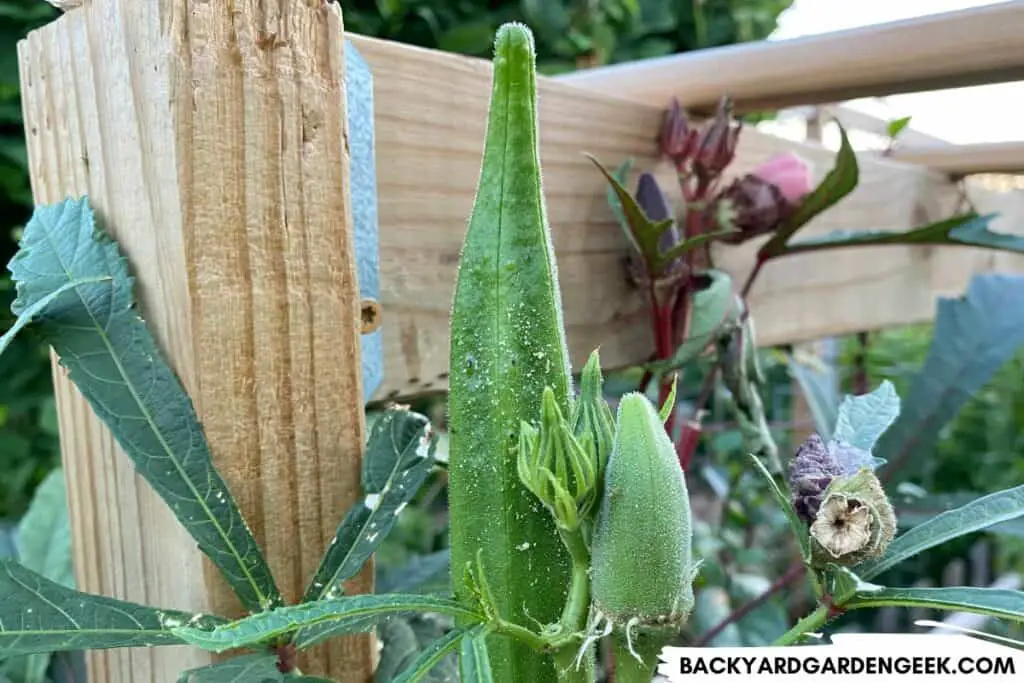
Notice the whitish specks on the okra? They’re easy to miss, but that’s a telltale sign that aphids are hiding somewhere, even if you can’t see any clusters quite yet.
I noticed this in the garden one day, and I didn’t do anything to see what would happen next. Sure enough, within just a few weeks, the aphid population had quadrupled on this single green okra plant.
Beyond whitish specks, you’ll also want to pay special attention to ants. If you see lots of ants on or around your plants, you’ve likely got aphids hiding somewhere since ants love the little sugary honeydew droplets that aphids leave behind as they feed.
2. Spray Aphids Repeatedly with Soapy Water
My favorite way to kill off aphids is with a simple soapy water spray.
You can add additional ingredients–such as garlic or hot pepper juices–but soapy water by itself is often all you’ll need to kill off aphids effectively.
Here’s my recipe for making your own simple spray:
- Fill a 1- or 2-gallon sprayer with water (7.5 L). I like 2-gallon sprayers most since you can often get several applications out of just one batch.
- Add 4-5 tablespoons of castile liquid soap (15-30 ml) per gallon of water. My favorite is Dr. Bronner’s Peppermint Castile Soap, but insecticidal soaps are a good option too (although be sure to follow the instructions on the bottle).
- Add the soap to the water, shake the sprayer well, then spray your plants with soapy water. You’ll want to spray both the tops and bottoms of the leaves since aphids are great at hiding.
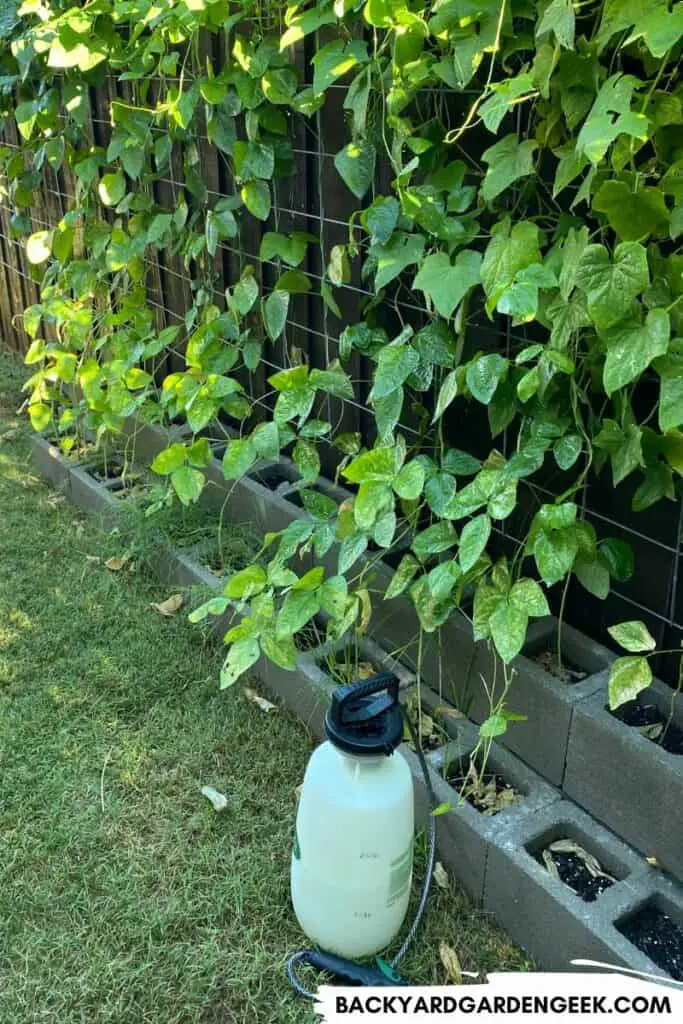
I typically spray my plants with soapy water once per day (usually in the late afternoon or early evening) for 5-7 days. If aphids don’t seem to be going anywhere, I’ll add step 3 below to my treatment schedule.
3. Spray Your Plants with Neem Oil
For particularly bad infestations, I like to add in a neem oil treatment once per week since, unlike soapy water, neem oil will coat the plant in a natural insecticide that’ll kill off aphids several days after they begin ingesting it.
If you want to learn as much as possible about neem oil, I recommend these articles:
- How Can I Make Neem Oil More Effective? My 10-Step Process
- How Long Does It Take for Neem Oil to Kill Bugs?
- How Long Does Neem Oil Last? A Complete Shelf Life Guide
- Washing Neem Oil Off Vegetables: Do This Before Eating
- What Bugs Does Neem Oil Repel and Get Rid Of?
See below for my neem oil recipe. Unlike soapy water sprays, neem oil can’t be stored once it’s mixed, so grab a smaller garden sprayer and use up everything you’ve mixed.
Here’s how I make my neem oil spray:
- I like to start with 1/2 gallon of water (1.9 liters). If you don’t own a 1/2 gallon sprayer, you can buy cheap ones online or at your local garden center.
- Fill up the garden sprayer with water, then add 1 tablespoon (15 ml) of neem oil. I like these neem oil brands: Verdana and Neem Bliss.
- Add 2 teaspoons (10 ml) of castile liquid soap, which will make it possible for the oil and water to mix properly. My favorite soap is Dr. Bronner’s Peppermint Castile Soap.
Once you’ve made your spray, spray it once per week while the infestation lasts, always making sure to spray your plants as the sun is setting so that you don’t accidentally burn them.
Using soapy water and neem oil sprays, I’ve found that most of my aphids infestations are long gone within 1-2 weeks.
More Information
If you’ve had issues with aphids, I recommend learning as much as you can about them since that’ll help you become adept at killing them off. Here are a few recommended articles if you’d like to keep reading:

